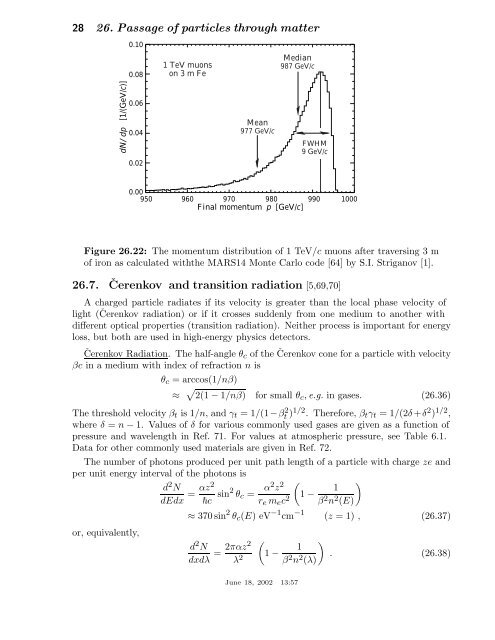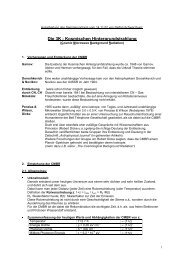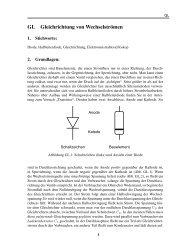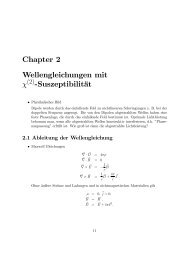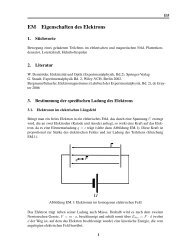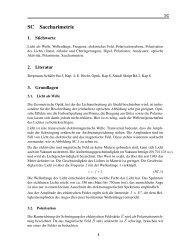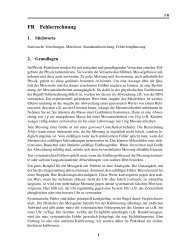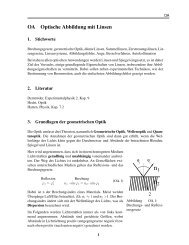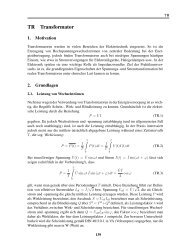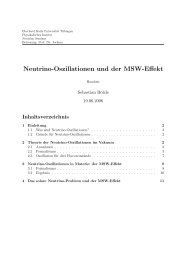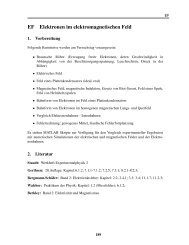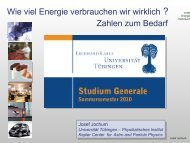26. passage of particles through matter - Particle Data Group
26. passage of particles through matter - Particle Data Group
26. passage of particles through matter - Particle Data Group
You also want an ePaper? Increase the reach of your titles
YUMPU automatically turns print PDFs into web optimized ePapers that Google loves.
28 <strong>26.</strong> Passage <strong>of</strong> <strong>particles</strong> <strong>through</strong> <strong>matter</strong><br />
0.10<br />
0.08<br />
1 TeV muons<br />
on 3 m Fe<br />
Median<br />
987 GeV/c<br />
dN/dp [1/(GeV/c)]<br />
0.06<br />
0.04<br />
0.02<br />
Mean<br />
977 GeV/c<br />
FWHM<br />
9 GeV/c<br />
0.00<br />
950 960 970 980 990 1000<br />
Final momentum p [GeV/c]<br />
Figure <strong>26.</strong>22: The momentum distribution <strong>of</strong> 1 TeV/c muons after traversing 3 m<br />
<strong>of</strong> iron as calculated withthe MARS14 Monte Carlo code [64] by S.I. Striganov [1].<br />
<strong>26.</strong>7. Čerenkov and transition radiation [5,69,70]<br />
A charged particle radiates if its velocity is greater than the local phase velocity <strong>of</strong><br />
light (Čerenkov radiation) or if it crosses suddenly from one medium to another with<br />
different optical properties (transition radiation). Neither process is important for energy<br />
loss, but both are used in high-energy physics detectors.<br />
Čerenkov Radiation. The half-angle θ c <strong>of</strong> the Čerenkov cone for a particle with velocity<br />
βc in a medium with index <strong>of</strong> refraction n is<br />
θ c = arccos(1/nβ)<br />
≈ √ 2(1 − 1/nβ) for small θ c , e.g. in gases. (<strong>26.</strong>36)<br />
The threshold velocity β t is 1/n, andγ t =1/(1−βt 2)1/2 . Therefore, β t γ t =1/(2δ +δ 2 ) 1/2 ,<br />
where δ = n − 1. Values <strong>of</strong> δ for various commonly used gases are given as a function <strong>of</strong><br />
pressure and wavelength in Ref. 71. For values at atmospheric pressure, see Table 6.1.<br />
<strong>Data</strong> for other commonly used materials are given in Ref. 72.<br />
The number <strong>of</strong> photons produced per unit path length <strong>of</strong> a particle with charge ze and<br />
per unit energy interval <strong>of</strong> the photons is<br />
or, equivalently,<br />
d 2 N<br />
dEdx = αz2<br />
~c sin2 θ c = α2 z 2 (<br />
)<br />
1<br />
r e m e c 2 1 −<br />
β 2 n 2 (E)<br />
≈ 370 sin 2 θ c (E) eV −1 cm −1 (z =1), (<strong>26.</strong>37)<br />
d 2 (<br />
)<br />
N<br />
dxdλ = 2παz2 1<br />
λ 2 1 −<br />
β 2 n 2 (λ)<br />
. (<strong>26.</strong>38)<br />
June 18, 2002 13:57


